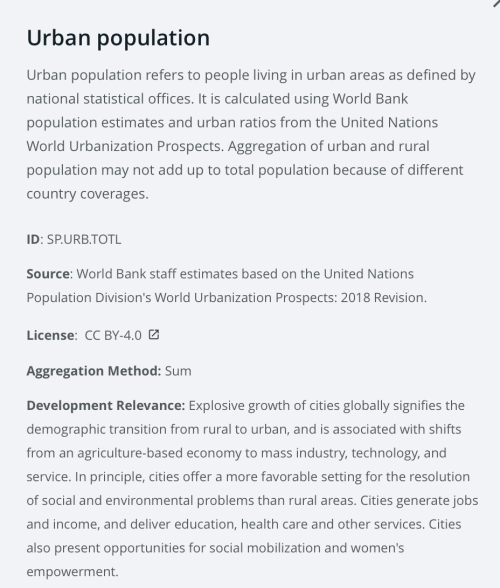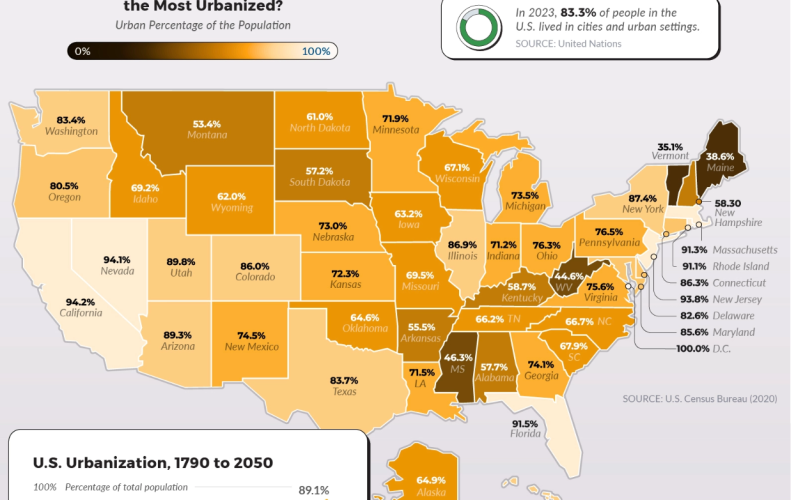Navigation
Install the app
How to install the app on iOS
Follow along with the video below to see how to install our site as a web app on your home screen.
Note: This feature may not be available in some browsers.
More options
You are using an out of date browser. It may not display this or other websites correctly.
You should upgrade or use an alternative browser.
You should upgrade or use an alternative browser.
Urbanization by state
- Thread starter MNElkNut
- Start date
jbseamus83
Well-known member
That's really interesting. I wouldn't have guessed some of those. Where is this map from? I'm with gouch and wonder about the specifics in defining urban vs rural for these stats.
Stone_Ice_1
Well-known member
While interesting this is a bit misleading I think for most people that look at it. This is not by any means a measure of empty space or the average amount of people you may find scattered throughout the rural and less populated areas. For example, Nevada is a good example in this metric of how misleading that is. 94.1%, one of the highest amounts of people in urban for a state. However if you've ever been through Nevada you know that a lot of it is in fact empty space and very sparesely populated. Its just that most of the people live in very small and concentrated areas.
While interesting this is a bit misleading I think for most people that look at it. This is not by any means a measure of empty space or the average amount of people you may find scattered throughout the rural and less populated areas. For example, Nevada is a good example in this metric of how misleading that is. 94.1%, one of the highest amounts of people in urban for a state. However if you've ever been through Nevada you know that a lot of it is in fact empty space and very sparesely populated. Its just that most of the people live in very small and concentrated areas.
yeah very easy to misinterpret.
it's simply what % of the people live in an urban setting.
you could have an entire state the size of wyoming with only 500 residents in the entire state and if they ALL live in a one square mile town in a nice little neighborhood made of up town houses and single family homes while the rest of the state is completely empty rolling sage prairie and beautiful forests and mountains, it would still the most "urban" state in the nation by this measure.
There are many communities that might be considered rural because they are made up of 2-to-10-acre ranchettes that are populated by very urban people that drive to work in the city and spend most of their time there. Are they rural or urban? Maybe "dispersed urban"
jbseamus83
Well-known member
This what I figured is going on with some of the figures for areas like VT and NH.There are many communities that might be considered rural because they are made up of 2-to-10-acre ranchettes that are populated by very urban people that drive to work in the city and spend most of their time there. Are they rural or urban? Maybe "dispersed urban"
SAJ-99
Well-known member
Had the same question as you originally. This may help. The data is from UN/World Bank. Seems they use definitions from individual countries.There are many communities that might be considered rural because they are made up of 2-to-10-acre ranchettes that are populated by very urban people that drive to work in the city and spend most of their time there. Are they rural or urban? Maybe "dispersed urban"

US census bureau definition.
To qualify as an urban area, the territory identified according to criteria must encompass at least 2,000 housing units or have a population of at least 5,000.
It looks like the UN leaves a lot of room for gray areas, which makes sense, I guess.Had the same question as you originally. This may help. The data is from UN/World Bank. Seems they use definitions from individual countries.
View attachment 275150
US census bureau definition.
To qualify as an urban area, the territory identified according to criteria must encompass at least 2,000 housing units or have a population of at least 5,000.
US census bureau definition.
To qualify as an urban area, the territory identified according to criteria must encompass at least 2,000 housing units or have a population of at least 5,000.
So, the town I live in is considered urban. But, if you want to buy a house here, and you qualify, you can get a USDA farm home loan to purchase that house because they considered this a rural area. As far as the US is concerned, it would appear that there is one standard for statistical purposes and another for practical purposes.
It is from visualcapitalist. No, I don't read visual capitalist. I got sent a link to it. I just thought it was an interesting graphic.
No matter how they measure it, I think of the political ramifications of urbanization. When you think about hunting related politics, how is this going to factor into policy in the coming years?
No matter how they measure it, I think of the political ramifications of urbanization. When you think about hunting related politics, how is this going to factor into policy in the coming years?
SAJ-99
Well-known member
Don't know the details, but I would find it hard to believe that you could get a home loan through the USDA without it being a farm?It looks like the UN leaves a lot of room for gray areas, which makes sense, I guess.
US census bureau definition.
To qualify as an urban area, the territory identified according to criteria must encompass at least 2,000 housing units or have a population of at least 5,000.
So, the town I live in is considered urban. But, if you want to buy a house here, and you qualify, you can get a USDA farm home loan to purchase that house because they considered this a rural area. As far as the US is concerned, it would appear that there is one standard for statistical purposes and another for practical purposes.
westbranch
Well-known member
Don't know the details, but I would find it hard to believe that you could get a home loan through the USDA without it being a farm?
They are likely referring to USDA RD (rural development) loans. We had a house in a small town (<3k people) in MN that the buyers purchased with RD loan. Kind of a PITA with requirements. Pretty sure a chunk of Kootenai county ID qualified up until 2017 or so.
Rural Development
Stone_Ice_1
Well-known member
I believe he is referring to the rural development loans. They don't have to be a farm. My house was originally done on a rural development loan and I am just outside Helena and while I have chickens it certainly isn't a farm.Don't know the details, but I would find it hard to believe that you could get a home loan through the USDA without it being a farm?
I knew someone that had just divorced and had a young child and qualified for the rural development loan for a small home. The home was in the middle of a town with a population of 8000 people. Not sure what "rural" means in the context of a usda loan.
Similar threads
- Replies
- 9
- Views
- 556
- Replies
- 10
- Views
- 874




